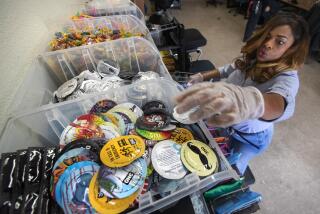Using a Condom Is an Acquired Skill
- Share via
Consider the condom: It is simple. It seems easy to use. It is cheap and available. More important, it rarely fails as a birth control method and effectively prevents the spread of most sexually transmitted diseases. But the maximum protection of a condom is afforded only if it is used properly.
This may seem uncomplicated. It isn’t. “The problem with using condoms,” said a 23-year-old UC Santa Barbara student, “is you pretty much put them on that moment, right before you have sex. First you have to find it. Then either you put it on really fast because it is a vibe killer and so you don’t think about what you are doing. Or you do it when you are drunk or you put it on in the dark. Obviously, it is a little bit of trial and error.”
It is the trial and error aspect of condom use that a team of researchers explored in a new study that some public health experts are calling one of the most comprehensive investigations into the many mistakes and problems young men experience when using condoms.
The research, published in this month’s issue of the journal Sexually Transmitted Diseases, found that among the subjects--158 Indiana University undergraduate, heterosexual men--condom use error was common. Forty-three percent of the men reported putting a condom on after sex had begun; 40% did not leave space at the tip; 30% placed the condom on inside out and had to reverse it; nearly one-third reported experiencing breakage or slippage during sex; and 32% reported experiencing sexual dysfunction because of a condom.
Sixty percent of the participants who filled out a questionnaire said they did not talk about condom use with their partner before sex.
“Very little research has focused on the correct use of condoms,” said the lead author of the study, Richard A. Crosby, professor of behavioral science and health education at the Rollins School of Public Health at Emory University.
“In the past, researchers have looked at the question of consistent condom use and how to promote consistent condom use. We looked at whether men used condoms correctly.”
Crosby said the study results cannot be generalized to the broader population because the study sample was small and was based on self-reported information. Nevertheless, public health experts said the findings are significant.
“Those numbers are alarming especially among college-aged men whom you would assume are older and smart,” said pediatrician Mark Schuster, director of the UCLA/Rand Center for Adolescent Health. “These are men who are having a lot of regular sex, and even though they are using condoms, they are using them incorrectly. They obviously need to learn how to use them.”
Tina Hoff, vice president of the Kaiser Family Foundation, dedicated to research about reproductive health, cited a recent survey of 1,500 sexually active youth in which 25% of the respondents said they need more information about how to use condoms.
Still, 80% of the young men who participated in the condom error study said they had been instructed in how to use condoms. “Our suspicion is that programs that claim to be giving proper condom-use instruction may not be doing a thorough job,” said Crosby. “Teaching correct condom use can be quite involved and certainly requires extensive, well-designed instruction by professionals rather than cursory instruction [such as reading a pamphlet]. It could happen in clinics, schools and community-based programs. It is a skill, and it requires knowledge and actual practice.”
Even when condoms are used correctly, they aren’t always fail proof. Condoms won’t prevent sexually transmitted diseases such as viral herpes and human papilloma virus, which are spread by skin-to-skin contact. About 3% of women whose partners use condoms consistently get pregnant.
One woman who teaches what might be called Condom 101 to undergraduates said that she has heard students complain of the condom errors and problems cited in Crosby’s study. “Students say those things happen all the time,” said Jane Bogart, director of the Center for Health Promotion at New York University’s Health Center. “If a student comes in and says, ‘I don’t like condoms because they break,’ I teach them about correct condom use. They are always convinced it is the brand. It would be helpful if there were directions on individually packaged condoms, which are the ones most people have, but there aren’t any.”
Bogart said that most breakage is due to user error. She gives classes and seminars on campus about how to use condoms properly. Along with clearing up misconceptions--such as two condoms are better than one--and teaching how to prevent breakage, she asks student to put a condom on a model of a phallus.
Bogart said she often blindfolds students to simulate the fumbling in the dark that is the backdrop to many campus sexual encounters. “There is this magical thinking about condoms,” said Bogart, “that people will just know how to use them.”





